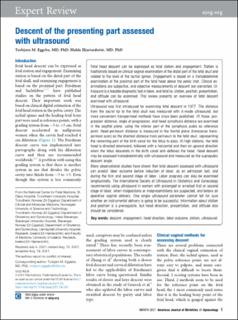| dc.description.abstract | Fetal head descent can be expressed as fetal station and engagement. Station is traditionally based on clinical vaginal examination of the distal part of the fetal skull and related to the level of the ischial spines. Engagement is based on a transabdominal examination of the proximal part of the fetal head above the pelvic inlet. Clinical examinations are subjective, and objective measurements of descent are warranted. Ultrasound is a feasible diagnostic tool in labor, and fetal lie, station, position, presentation, and attitude can be examined. This review presents an overview of fetal descent examined with ultrasound. Ultrasound was first introduced for examining fetal descent in 1977. The distance from the sacral tip to the fetal skull was measured with A-mode ultrasound, but more convenient transperineal methods have since been published. Of those, progression distance, angle of progression, and head-symphysis distance are examined in the sagittal plane, using the inferior part of the symphysis pubis as reference point. Head-perineum distance is measured in the frontal plane (transverse transperineal scan) as the shortest distance from perineum to the fetal skull, representing the remaining part of the birth canal for the fetus to pass. At high stations, the fetal head is directed downward, followed with a horizontal and then an upward direction when the fetus descends in the birth canal and deflexes the head. Head descent may be assessed transabdominally with ultrasound and measured as the suprapubic descent angle. Many observational studies have shown that fetal descent assessed with ultrasound can predict labor outcome before induction of labor, as an admission test, and during the first and second stage of labor. Labor progress can also be examined longitudinally. The International Society of Ultrasound in Obstetrics and Gynecology recommends using ultrasound in women with prolonged or arrested first or second stage of labor, when malpositions or malpresentations are suspected, and before an operative vaginal delivery. One single ultrasound parameter cannot tell for sure whether an instrumental delivery is going to be successful. Information about station and position is a prerequisite, but head direction, presentation, and attitude also should be considered. | en_US |

